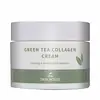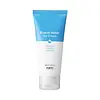What's inside
What's inside
 Key Ingredients
Key Ingredients

 Benefits
Benefits

 Concerns
Concerns

No concerns
 Ingredients Side-by-side
Ingredients Side-by-side

Water
Skin ConditioningButylene Glycol
HumectantGlycerin
HumectantSqualane
EmollientCyclomethicone
EmollientParaffinum Liquidum
EmollientSodium Hyaluronate
HumectantCetyl Ethylhexanoate
EmollientMacadamia Integrifolia Seed Oil
Skin ConditioningDimethicone
Emollient1,2-Hexanediol
Skin ConditioningCaprylic/Capric Triglyceride
MaskingCetearyl Alcohol
EmollientStearic Acid
CleansingDimethicone/Vinyl Dimethicone Crosspolymer
Skin ConditioningGlyceryl Stearate
EmollientPEG-100 Stearate
Hydrolyzed Collagen
EmollientBetaine
HumectantMethyl Gluceth-20
HumectantPEG-10 Dimethicone
Skin ConditioningPolysorbate 60
EmulsifyingSorbitan Isostearate
EmulsifyingBeeswax
Emulsion StabilisingCarbomer
Emulsion StabilisingSorbitan Stearate
EmulsifyingSodium Polyacrylate
AbsorbentC13-14 Isoparaffin
EmollientLaureth-7
EmulsifyingHydrogenated Lecithin
EmulsifyingLinoleic Acid
CleansingCeramide NP
Skin ConditioningCamellia Japonica Seed Oil
EmollientArginine
MaskingMyrciaria Dubia Fruit Extract
Skin ConditioningEuterpe Oleracea Fruit Extract
Aloe Barbadensis Leaf Extract
EmollientCamellia Sinensis Leaf Extract
AntimicrobialPanthenol
Skin ConditioningAllantoin
Skin ConditioningAdenosine
Skin ConditioningDisodium EDTA
Panax Ginseng Cell Culture Extract
Skin ConditioningBambusa Vulgaris Callus Culture Extract
Skin ConditioningAloe Vera Callus Extract
AntioxidantLeontopodium Alpinum Extract
Skin ConditioningThymus Vulgaris Extract
PerfumingBuddleja Davidii Extract
Skin ConditioningSnail Secretion Filtrate
Skin ConditioningAralia Cordata Extract
Skin ConditioningSaururus Chinensis Extract
Skin ConditioningPortulaca Oleracea Extract
Skin ConditioningElsholtzia Splendens Extract
Skin ConditioningPhenoxyethanol
PreservativeEthylhexylglycerin
Skin ConditioningCI 19140
Cosmetic ColorantCI 15985
Cosmetic ColorantParfum
MaskingLinalool
PerfumingLimonene
PerfumingWater, Butylene Glycol, Glycerin, Squalane, Cyclomethicone, Paraffinum Liquidum, Sodium Hyaluronate, Cetyl Ethylhexanoate, Macadamia Integrifolia Seed Oil, Dimethicone, 1,2-Hexanediol, Caprylic/Capric Triglyceride, Cetearyl Alcohol, Stearic Acid, Dimethicone/Vinyl Dimethicone Crosspolymer, Glyceryl Stearate, PEG-100 Stearate, Hydrolyzed Collagen, Betaine, Methyl Gluceth-20, PEG-10 Dimethicone, Polysorbate 60, Sorbitan Isostearate, Beeswax, Carbomer, Sorbitan Stearate, Sodium Polyacrylate, C13-14 Isoparaffin, Laureth-7, Hydrogenated Lecithin, Linoleic Acid, Ceramide NP, Camellia Japonica Seed Oil, Arginine, Myrciaria Dubia Fruit Extract, Euterpe Oleracea Fruit Extract, Aloe Barbadensis Leaf Extract, Camellia Sinensis Leaf Extract, Panthenol, Allantoin, Adenosine, Disodium EDTA, Panax Ginseng Cell Culture Extract, Bambusa Vulgaris Callus Culture Extract, Aloe Vera Callus Extract, Leontopodium Alpinum Extract, Thymus Vulgaris Extract, Buddleja Davidii Extract, Snail Secretion Filtrate, Aralia Cordata Extract, Saururus Chinensis Extract, Portulaca Oleracea Extract, Elsholtzia Splendens Extract, Phenoxyethanol, Ethylhexylglycerin, CI 19140, CI 15985, Parfum, Linalool, Limonene
Water
Skin ConditioningButylene Glycol
HumectantXylitol
HumectantPropanediol
SolventGlycerin
HumectantBetaine
Humectant2,3-Butanediol
HumectantSqualane
EmollientGlyceryl Glucoside
HumectantAloe Barbadensis Leaf Extract
EmollientEucommia Ulmoides Bark Extract
AntioxidantAnthemis Nobilis Flower Extract
MaskingMalachite Extract
AntioxidantPanthenol
Skin ConditioningAllantoin
Skin ConditioningArginine
MaskingSodium Acrylates Copolymer
Ammonium Acryloyldimethyltaurate/Vp Copolymer
Cetearyl Olivate
Caprylyl Glycol
EmollientLecithin
EmollientSorbitan Olivate
EmulsifyingHydroxyacetophenone
AntioxidantPentylene Glycol
Skin ConditioningDipotassium Glycyrrhizate
HumectantCarbomer
Emulsion StabilisingEthylhexylglycerin
Skin Conditioning1,2-Hexanediol
Skin ConditioningDisodium EDTA
Water, Butylene Glycol, Xylitol, Propanediol, Glycerin, Betaine, 2,3-Butanediol, Squalane, Glyceryl Glucoside, Aloe Barbadensis Leaf Extract, Eucommia Ulmoides Bark Extract, Anthemis Nobilis Flower Extract, Malachite Extract, Panthenol, Allantoin, Arginine, Sodium Acrylates Copolymer, Ammonium Acryloyldimethyltaurate/Vp Copolymer, Cetearyl Olivate, Caprylyl Glycol, Lecithin, Sorbitan Olivate, Hydroxyacetophenone, Pentylene Glycol, Dipotassium Glycyrrhizate, Carbomer, Ethylhexylglycerin, 1,2-Hexanediol, Disodium EDTA
 Reviews
Reviews

Ingredients Explained
These ingredients are found in both products.
Ingredients higher up in an ingredient list are typically present in a larger amount.
1,2-Hexanediol is a synthetic liquid and another multi-functional powerhouse.
It is a:
- Humectant, drawing moisture into the skin
- Emollient, helping to soften skin
- Solvent, dispersing and stabilizing formulas
- Preservative booster, enhancing the antimicrobial activity of other preservatives
Allantoin is a soothing ingredient known for its protective and moisturizingg properties. Because of this, it is often added to products with strong active ingredients.
Studies show higher concentrations of this ingredient can promote wound healing.
Though it can be derived from the comfrey plant, allantoin is produced synthetically for cosmetic products to ensure purity.
Learn more about AllantoinAloe Barbadensis Leaf Extract is an extract of the leaves of the aloe, Aloe barbadensis, Liliaceae.
Aloe is one of the most well-known natural soothing ingredients, and for good reason. It’s full of water and has a cooling, calming effect on the skin, especially when it’s sunburned, itchy, or irritated. Aloe also helps your skin stay hydrated and smooth by mimicking what healthy skin naturally produces. On top of that, it contains vitamins and nutrients that support skin recovery.
It doesn’t protect you from the sun, but it can help your skin bounce back after too much time in it.
Let’s get into the details:
Aloe contains antioxidant Vitamins A, C, and E, which help fight off free radicals (unstable molecules from things like pollution that can damage your skin).
It’s also rich in polysaccharides, which are natural sugars that help hydrate the skin by acting like the skin’s own moisturizing agents. These, along with other sugars like monosaccharides, help form a protective barrier that locks in moisture.
Aloe works as both a humectant and an emollient. That means it draws water into the skin (humectant) and helps trap it there (emollient), making it an effective natural moisturizer.
You’ll also find a mix of other skin-supporting ingredients in aloe, including folic acid, choline, calcium, amino acids, fatty acids, and even Vitamin B12.
Out of the 420+ species of aloe, Aloe barbadensis is the most widely used in skincare products thanks to its gentle yet effective properties.
There are over 420 species of aloe but Aloe Barbadensis is the most commonly used for topical products.
Learn more about Aloe Barbadensis Leaf ExtractArginine is an amino acid that is important for human development. Your body uses is it to produce hair keratin and skin collagen.
As a cosmetic ingredient, Arginine has antioxidant properties and can also help repair damaged skin. This ingredient is derived either synthetically or from animals.
Arginine isn't fungal acne safe when used in the presence of other lipids (fats, fatty acids, oils, esters, etc). Oils and fats occur naturally within the skin, so take caution when using Arginine if you're prone to fungal acne.
Learn more about ArginineBetaine is a common humectant (a substance that promotes retention of moisture). It's known to be gentle on the skin and can help balance hydration.
This ingredient is best for improving hydration and soothing irritated skin. Studies also show it helps even out skin tone.
Fun fact: Betaine is naturally created in the skin and body. The kind found within cosmetic products can be either plant-derived or synthetic.
Another name for betaine is trimethylglycine.
Learn more about BetaineButylene Glycol (or BG) is used within cosmetic products for a few different reasons:
Overall, Butylene Glycol is a safe and well-rounded ingredient that works well with other ingredients.
Though this ingredient works well with most skin types, some people with sensitive skin may experience a reaction such as allergic rashes, closed comedones, or itchiness.
Learn more about Butylene GlycolCarbomer is a polymer of acrylic acid. Its main role is to create a gel consistency.
A high amount of carbomer can cause pilling or balling up of products. Don't worry, most products contain 1% or less of carbomer.
Disodium EDTA plays a role in making products more stable by aiding other preservatives.
It is a chelating agent, meaning it neutralizes metal ions that may be found in a product.
Disodium EDTA is a salt of edetic acid and is found to be safe in cosmetic ingredients.
Learn more about Disodium EDTAEthylhexylglycerin (we can't pronounce this either) is commonly used as a preservative and skin softener. It is derived from glyceryl.
You might see Ethylhexylglycerin often paired with other preservatives such as phenoxyethanol. Ethylhexylglycerin has been found to increase the effectiveness of these other preservatives.
Glycerin is already naturally found in your skin. It helps moisturize and protect your skin.
A study from 2016 found glycerin to be more effective as a humectant than AHAs and hyaluronic acid.
As a humectant, it helps the skin stay hydrated by pulling moisture to your skin. The low molecular weight of glycerin allows it to pull moisture into the deeper layers of your skin.
Hydrated skin improves your skin barrier; Your skin barrier helps protect against irritants and bacteria.
Glycerin has also been found to have antimicrobial and antiviral properties. Due to these properties, glycerin is often used in wound and burn treatments.
In cosmetics, glycerin is usually derived from plants such as soybean or palm. However, it can also be sourced from animals, such as tallow or animal fat.
This ingredient is organic, colorless, odorless, and non-toxic.
Glycerin is the name for this ingredient in American English. British English uses Glycerol/Glycerine.
Learn more about GlycerinPanthenol is a common ingredient that helps hydrate and soothe the skin. It is found naturally in our skin and hair.
There are two forms of panthenol: D and L.
D-panthenol is also known as dexpanthenol. Most cosmetics use dexpanthenol or a mixture of D and L-panthenol.
Panthenol is famous due to its ability to go deeper into the skin's layers. Using this ingredient has numerous pros (and no cons):
Like hyaluronic acid, panthenol is a humectant. Humectants are able to bind and hold large amounts of water to keep skin hydrated.
This ingredient works well for wound healing. It works by increasing tissue in the wound and helps close open wounds.
Once oxidized, panthenol converts to pantothenic acid. Panthothenic acid is found in all living cells.
This ingredient is also referred to as pro-vitamin B5.
Learn more about PanthenolSqualane is an emollient that helps the skin hold onto moisture. It's an oily liquid that occurs naturally in certain types of fish and plant oils.
Because squalane boosts hydration in the skin, it also comes with plenty of benefits: it is an antioxidant and can help fight free radicals and skin damage. Squalane is also found to have a detoxifying effect when applied.
Squalane comes from squalene, which occurs naturally within the sebum of our skin. It is one of the oils our skin produces to keep itself hydrated. Squalane is the hydrogenated version of squalene and has a longer shelf life.
Research shows that squalane is non-irritating (even at 100% concentration).
In general, it's a fantastic ingredient. It does a great job at hydrating the skin, and it's suitable for those with sensitive skin.
The source of squalane may impact malassezia / fungal acne. This is because olive oil derived squalane can contain impurities such as fatty acids and plant waxes. Sugarcane derived squalane is recommended for anyone with malassezia concerns.
Is squalane vegan?
This depends on the source. Squalane can be derived from both plants and animals. Most squalane used in skincare comes from plants.
Please note: the source of squalane is only known if disclosed by the brand. We recommend reaching out to the brand if you have any questions about their squalane.
Read more about squalene with an "e".
Is squalane an oil?
Squalane is often called an oil, but it’s technically not; it’s a hydrocarbon, meaning it’s only made of carbon and hydrogen, unlike true oils which are triglycerides made of fatty acids and glycerol.
The term “oil-free” isn’t regulated, so companies can define it however they want. Some exclude all oils, while others just avoid mineral oil or comedogenic oils.
While some people avoid oils thinking they cause breakouts, the right kind of oil (or oil-like ingredient like squalane) can actually help balance and hydrate your skin. It’s worth testing out simple oils or squalane to see what works best for your skin.
Learn more about SqualaneWater. It's the most common cosmetic ingredient of all. You'll usually see it at the top of ingredient lists, meaning that it makes up the largest part of the product.
So why is it so popular? Water most often acts as a solvent - this means that it helps dissolve other ingredients into the formulation.
You'll also recognize water as that liquid we all need to stay alive. If you see this, drink a glass of water. Stay hydrated!
Learn more about Water